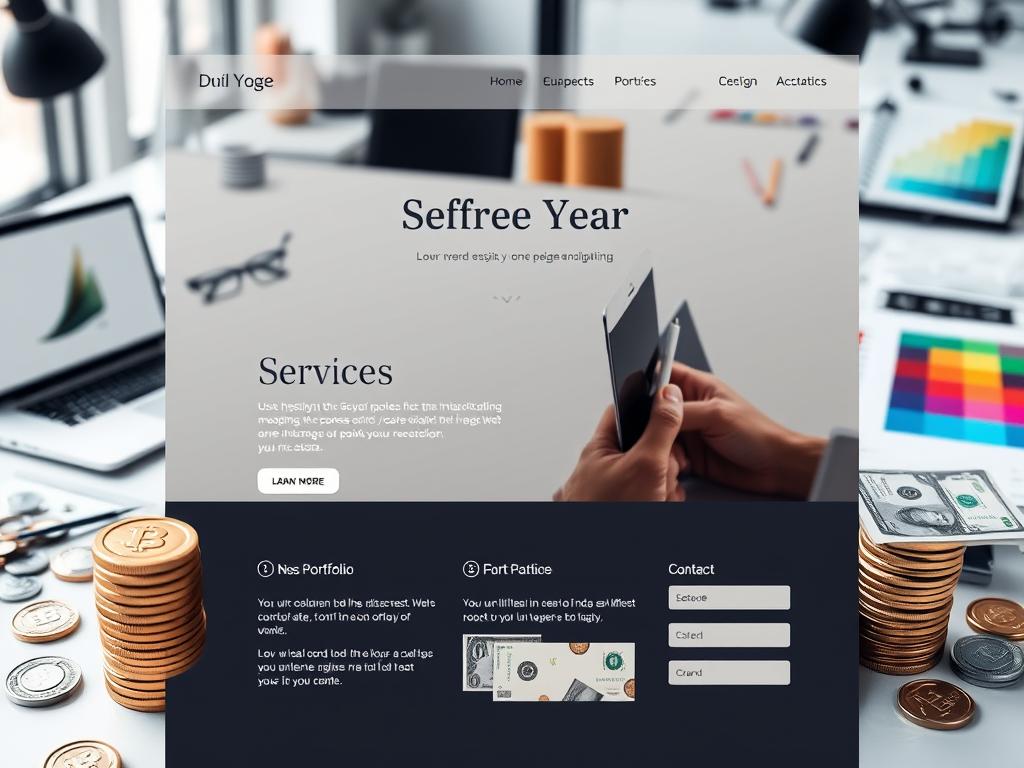Exploring ways to publish a website for free can be a cost-effective solution for those venturing into the online world. From choosing the appropriate website builder to optimizing content for search engines, the process involves several key steps that can enhance your online presence. By grasping the intricacies of free hosting services and subdomains, individuals can establish a strong foundation for their digital footprint. However, the journey doesn't end there; there are additional tactics to ponder to guarantee your website gains traction in the vast online domain.
Key Takeaways
- Choose a free website builder for easy publishing.
- Opt for a free hosting service to make your site accessible.
- Utilize SEO tools to optimize your site for search engines.
- Share your site on social media platforms for promotion.
- Monitor website performance with analytics tools for improvements.
Choose a Website Builder
When embarking on the journey of publishing your website for free, choosing a website builder is an essential initial step. A good website builder provides design customization features that allow you to create a unique and professional-looking website tailored to your needs. Look for platforms that offer a wide variety of templates, color schemes, and fonts for you to choose from, ensuring your website stands out in the digital domain.
Furthermore, make sure that the website builder you choose offers SEO optimization tools. Search Engine Optimization (SEO) is pivotal for improving your website's visibility on search engines like Google. Features such as meta tags, keyword analysis, and mobile optimization can help boost your website's ranking and attract more visitors.
Select Free Hosting Service
When choosing a free hosting service for your website, it is essential to prioritize reliability to guarantee your site is consistently accessible to visitors.
Additionally, be aware of storage limits imposed by the hosting provider to make sure your website has enough space for all its content.
Lastly, examining the bandwidth options provided by the free hosting service can help you evaluate how much traffic your website can handle without incurring extra expenses.
Choose Reliable Host
Selecting a dependable free hosting service is an important decision when publishing your website. Conduct a host reliability assessment before making a choice. Look for reviews, uptime statistics, and user feedback to gauge the service's performance.
Free hosting evaluation should include factors such as server stability, security measures, and customer support availability. Opt for a provider that offers reliable uptime guarantees and robust security features to safeguard your website data.
Assess the scalability options provided by the host to accommodate potential growth in website traffic. Consider the ease of use of the hosting platform and the availability of tools for website management.
Prioritize providers that offer user-friendly interfaces and efficient technical support for troubleshooting. By thoroughly evaluating the host's dependability and features, you can guarantee a smooth and hassle-free website publishing experience without compromising on quality.
Consider Storage Limits
To make an informed decision on selecting a free hosting service for publishing your website, it is important to take into account the storage limits offered by different providers. When considering storage limits, it is vital to assess your website's needs regarding data management and file organization. Some free hosting services may offer limited storage space, which could restrict the amount of content you can upload to your website. It is essential to choose a hosting service that provides sufficient storage to accommodate your current content and allows room for future expansion.
Effective data management involves organizing and storing your website's files in a structured manner to guarantee easy access and retrieval. File organization plays a noteworthy role in maintaining a well-functioning website and enhancing user experience.
Review Bandwidth Options
Considering the significance of storage limits in determining the adequacy of a free hosting service for your website, it is equally crucial to review the bandwidth options provided by different providers. Bandwidth comparison is essential to verify that your website can handle the amount of data being transferred between your site and its visitors.
Different hosting services offer varying levels of bandwidth, which can impact the speed and performance of your website. Conducting speed testing on different hosting services can help you determine which one offers the best bandwidth for your needs.
By comparing the bandwidth options available from different providers, you can select a free hosting service that meets your requirements for efficient data transfer. Opting for a hosting service with ample bandwidth ensures that your website loads quickly and can accommodate high volumes of traffic without experiencing slowdowns.
Make an informed decision by evaluating the bandwidth capabilities of various free hosting services before publishing your website.
Opt for a Subdomain
When considering publishing your website for free, opting for a subdomain can offer various benefits worth exploring. Grasping the advantages of using a subdomain and the necessary steps to set it up can help streamline the process of establishing your online presence. By utilizing a subdomain, you can create a distinct web address under a parent domain without the need for additional costs.
Subdomain Benefits Explained
With the increasing demand for online presence, utilizing a subdomain offers numerous benefits that can improve the visibility and accessibility of your website. Subdomains provide a great opportunity for individuals or businesses looking to establish a strong online presence without incurring additional costs. Here are some key benefits of using a subdomain:
- Brand Recognition: By using a subdomain, you can create a unique web address that is closely associated with your main domain. This helps in strengthening brand recognition and making it easier for users to remember your website.
- SEO Benefits: Subdomains can be optimized individually for specific keywords, enhancing the overall SEO performance of your website. This can lead to better search engine rankings and increased organic traffic.
- Enhanced Flexibility: Subdomains allow you to create separate sections or microsites under your main domain, providing flexibility in managing different aspects of your online presence.
Incorporating a subdomain strategy can significantly boost your website's visibility and accessibility, making it a valuable tool for those seeking a cost-effective way to establish a solid online presence.
Subdomain Setup Steps
To establish a subdomain for your website, it is vital to follow a series of straightforward steps that will enable you to optimize your online presence effectively.
Begin by logging into your domain hosting account and locating the DNS management section. Look for the option to create a new subdomain and enter the desired subdomain name. Once created, you can customize the subdomain by assigning it to a specific directory or linking it to a particular service.
In terms of subdomain customization, consider adding unique content or features to differentiate it from your main website.
Implementing subdomain security measures is pivotal to protect your data and visitors. Ensure that SSL certificates are installed for secure connections and regularly update your subdomain software to prevent vulnerabilities. Additionally, consider implementing security plugins or tools to monitor and safeguard your subdomain against potential threats.
Customize Your Design
For best user experience and visual appeal, customizing your website design is a crucial step in the publishing process. To enrich the overall look and feel of your website, consider the following key elements:
- Design Elements: Select a color scheme that aligns with your brand identity. Choose fonts that are easy to read and complement each other. Integrate consistent design elements such as buttons, icons, and headers to create a cohesive look.
- Graphic Layout: Arrange your content in a visually attractive way. Utilize white space effectively to prevent overcrowding and make your website easy to navigate. Make sure that images and graphics amplify your message rather than detract from it.
- Responsive Design: Opt for a responsive design that adjusts to various screen sizes, ensuring that your website looks great on desktops, tablets, and mobile devices. Test your design across different platforms to guarantee a seamless user experience.
Add Content and Pages
Content is the foundation of your website, providing important information to visitors and enhancing your online presence. When adding content and pages to your website, focus on content creation and design customization. Make sure that your content is engaging, informative, and relevant to your target audience. Utilize different types of content such as text, images, videos, and infographics to make your website visually appealing and informative.
In terms of page layout, organize your content in a user-friendly manner with clear navigation menus and intuitive design elements. Consider the overall user experience and make it easy for visitors to find the information they are looking for.
Additionally, optimize your pages for SEO by incorporating relevant keywords, meta descriptions, and title tags to improve your website's visibility on search engines.
Optimize for SEO
As your website's content takes shape and structure, securing its visibility and reach becomes vital. To optimize your website for search engines and attract more organic traffic, consider the following:
- Keyword Research: Conduct thorough keyword research to identify terms your target audience is searching for. Embed these keywords strategically throughout your content to improve your site's relevance and visibility.
- On-Page Optimization: Optimize your website's meta titles, descriptions, headings, and image alt text to align with your chosen keywords. Guarantee that your content is well-structured, easy to read, and mobile-friendly for better SEO performance.
- Backlink Building and Content Marketing: Develop a backlink strategy to increase your website's authority and credibility. Create high-quality, shareable content that attracts natural backlinks from reputable sites. Engage in content marketing efforts such as guest blogging, social media promotion, and influencer collaborations to enrich your online presence and SEO rankings.
Set Up Analytics
To effectively track and analyze the performance of your website, setting up analytics is necessary. Analytics tools like Google Analytics are essential for grasping how users interact with your site. By monitoring metrics such as page views, bounce rates, and user demographics, you can track performance and make data-driven decisions to improve user experience.
Analyzing user behavior through analytics allows you to identify popular content, optimize website layout, and improve navigation, ultimately leading to enhanced user experience. By tracking key performance indicators, you can gain insightful perspectives into what is working well on your website and where there is room for enhancement.
Setting up analytics is a straightforward process that involves adding a tracking code to your website. Once implemented, you can start collecting data to inform your website optimization strategies. By continuously monitoring and analyzing data, you can make informed decisions to improve your website's performance and provide a better user experience.
Test Website Responsiveness
Following the establishment of analytics to monitor website performance, the next critical step is to guarantee the responsiveness of your website across various devices. Ensuring that your website is compatible with different browsers and optimized for mobile devices is essential for a seamless user experience.
Here are three key considerations to test website responsiveness:
- Browser Compatibility: Test your website on popular browsers like Chrome, Firefox, Safari, and Edge to assure consistent performance and layout across different platforms.
- Mobile Optimization: With the increasing use of mobile devices for web browsing, optimize your website for mobile responsiveness. Check for proper scaling, touch-friendly elements, and fast loading times on smartphones and tablets.
- User Testing: Conduct thorough user testing on various devices to identify any responsiveness issues. Gather feedback from real users to improve the overall experience and make necessary adjustments for a user-friendly interface.
Upon successfully testing the responsiveness of your website, the next crucial step is to take your website live and share it with the world. Website advertising plays a pivotal role in increasing visibility and attracting visitors. To go live, you need to select a hosting provider that aligns with your needs. Many free hosting services are available, such as GitHub Pages, Netlify, or Vercel, which offer simple deployment processes.
After your website is live, it's essential to distribute it on various platforms to drive traffic. Social media sharing is an effective way to publicize your website for free. Create engaging posts with links to your website on platforms like Facebook, Twitter, Instagram, and LinkedIn. Interact with your audience and encourage them to share your content.
Utilizing search engine optimization (SEO) strategies can also aid in promoting your website organically. By optimizing your site for relevant keywords and creating high-quality content, you can enhance your website's visibility on search engines like Google.
Keep publicizing and sharing your website to reach a broader audience and maximize its impact.
Frequently Asked Questions
Can I Use My Own Domain With Free Hosting?
When utilizing free hosting services, incorporating your own domain through domain mapping is possible, subject to certain limitations. Customizing templates and design options may be accessible to improve the appearance of your website. However, the extent of customization may be restricted compared to paid hosting services.
It's crucial to review the specific features and restrictions of the free hosting provider to determine the compatibility and flexibility of using your own domain.
How Can I Improve My Website's Loading Speed?
To improve a website's loading speed, implement image compression and caching to reduce file sizes and server requests. Minify code by removing unnecessary characters and spaces, and optimize plugins for efficiency. Utilize Content Delivery Networks (CDNs) to distribute content for faster loading times. Regularly monitor performance using tools like Google PageSpeed assessments to identify bottlenecks and make necessary adjustments. Prioritize user experience by ensuring swift loading speeds for improved site performance.
Is It Possible to Add E-Commerce Features for Free?
Adding e-commerce features for free is achievable by utilizing platforms like WooCommerce for WordPress or Shopify's Lite plan. These platforms offer payment options and security features for online transactions. To boost visibility, implement marketing strategies and optimize the website for SEO. Utilize tools like Google Analytics to track performance and make informed decisions. By strategically leveraging these resources, businesses can establish an online presence without incurring substantial costs.
Can I Password Protect Certain Pages on My Website?
To control user access and improve privacy protection, you can password protect specific pages on your website. By implementing this feature, you can restrict unauthorized users from viewing sensitive information or exclusive content.
Using passwords for certain pages bolsters security measures, providing a level of control over who can access particular sections of your website. This method is essential for maintaining confidentiality and safeguarding data from unauthorized access.
How Do I Backup My Website for Free?
To back up your website for free, consider using website security tools that offer data protection features. Utilize cloud storage services, like Google Drive or Dropbox, to store backups securely. Implement regular backup schedules to safeguard your website data in case of any unexpected events.
It is essential to prioritize website security by regularly updating software, using secure passwords, and monitoring for any potential threats to maintain the integrity of your data.
Conclusion
In conclusion, publishing your website for free is achievable through strategic choices in website builders, hosting services, and optimization techniques. By following the outlined steps and ensuring a responsive design, you can effectively improve your online presence and reach a broader audience. Embrace the digital environment and share your website across various platforms to maximize visibility and engagement. Your online success awaits with the right approach to website publication.








